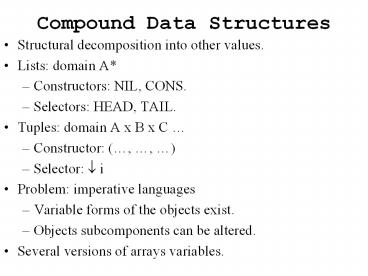Compound Data Structures - PowerPoint PPT Presentation
Title:
Compound Data Structures
Description:
access array is represented by an infinite function expression. ... A declaration activates the storage allocation strategy specified by its type structure. ... – PowerPoint PPT presentation
Number of Views:22
Avg rating:3.0/5.0
Title: Compound Data Structures
1
Compound Data Structures
- Structural decomposition into other values.
- Lists domain A
- Constructors NIL, CONS.
- Selectors HEAD, TAIL.
- Tuples domain A x B x C
- Constructor (, , )
- Selector ? i
- Problem imperative languages
- Variable forms of the objects exist.
- Objects subcomponents can be altered.
- Several versions of arrays variables.
2
Arrays
- Collection of homogeneous objects indexed by a
set of scalar values. - Homogeneity ? all components have same structure.
- Allocation of storage and typechecking easy.
- Both tasks can be performed by compiler.
- Selector operation indexing.
- Scalar index set primitive domain with
relational and arithmetic operations. - Restricted by lower and upper bounds.
3
Linear Vector of Values
- IDArray (Index ? Location) x Lowerbound x
UpperBound - Index is index set
- lessthan, greaterthan, equals.
- Lowerbound Upperbound Index.
- First component maps indices to the locations
that contain the storable values. - Second and third component denote the bounds
allowed on array indices.
4
Multidimensional Arrays
- Array may contain other arrays.
- Threedimensional array is vector whose
components are twodimensional vectors. - Hierarchy of arrays defined as infinite sum
- 1DArray (Index ? Location) x Index x Index.
- (n1)DArray (Index ? nDArray) x Index x Index.
- 1DArray maps indices to locations, 2DArray maps
indices to 1D arrays, . . . .
5
Multidimensional Arrays
- a ? MDArray
- inkDArray(map, lower, upper) for some k gt 1
- accessarray
- Index ? MDArray ?(Location MDArray Errvalue)
- accessarray ?i. ?r. cases r of
- is1DArray(a) ? index1 a i
- is2DArray(a) ? index2 a i
- . . .
- iskDArray(a) ? indexK a i
- . . .
- end
6
- index m ?(map, lower, upper). ? i.
- (i lessthan lower) or (i greaterthan upper) ?
- inErrvalue() MInject(map(i))
- 1Inject ? l.inLocation(l)
- . . .
- (n1)Inject ? a. inMDArray( innDArray(a))
7
Multidimensional Arrays
- accessarray is represented by an infinite
function expression. - By using pair representation of disjoint union
elements, operation is convertible to finite,
computable format. - Operation performs onelevel indexing upon array
a returning another array if a has more than one
dimension. - Still model is to clumsy to be used in practice.
- Real programming languages allow arrays of
numbers, record structures, sets, . . . !
8
System of Type Declarations
- T ? Typestructure
- S ? Subscript
- T nat bool array N1... N2 of T record D
end - D D1D2var IT
- C IS E ...
- E ... IS ...
- S E E, S
9
- Denotablevalue
- (Natlocn Boollocn Array Record
Errvalue)? - l ? Natlocn Boollocn Location
- a ? Array (Nat ? Denotablevalue) x Nat x Nat
- r ? Record Environment Id ? Denotablevalue
10
Semantics of Type Declarations
- T Typestructure ? Store ? (Denotablevalue x
Poststore) - Tnat ? s
- let (l,p) (allocatelocn s)
- in (inNatlocn(l), p)
- Tbool ? s
- let (l,p) (allocatelocn s)
- in (inBoollocn(l), p)
11
- Tarray N1... N2of T ? s
- let n1 NN1 in let n2 NN2
- in n1 greaterthan n2 (inErrvalue(), (signalerr
s)) - getstorage n1 (emptyarray n1 n2 ) s
- Trecord D end ? s let (e, p) (DD
emptyenv s) - in (inRecord(e), p)
- Type structure expressions are mapped to storage
allocation - actions!
12
Semantics of Type Declarations
- getstorage Nat ? Array ? Store ?
(Denotablevalue x Poststore) - getstorage ? n ? a ? s n greater n 2 ?
- (inArray(a), return s)
- let (d, p) TTs
- in (check(getstorage (n plus one)
- (augmentarray n d a)))(p)
13
- augmentarray Nat ? Denotablevalue ? Array ?
Array - augmentarray ? n ? d ?(map, lower, upper)
- (n ? d map, lower, upper)
- emptyarray Nat ? Nat ? Array
- emptyarray ? n1 ? n2 ((? ninErrvalue())
n1 n2 ) - getstorage iterates from lower bound of array to
upper bound allocating the proper amount of
storage for a component. - augmentarray inserts the component into the
array.
14
Declarations
- D Declaration ? Environment ? Store ?
- (Environment x Poststore)
- DD1D2 ? e ? s
- let (e, p) (DD1e s) in (check (DD2
e))(p) - Dvar IT ? e ? s
- let (d, p) TTs in ((updateenv I d e),
p) - A declaration activates the storage allocation
strategy specified by its type structure.
15
Array Indexing
- S Subscript ?Array ? Environment ? Store ?
Storablevalue - SE ? a?e ? s
- cases (EEe s) of . . .
- isNat(n) accessarray n a end
- SE, S ? a ? e ? s
- cases (EEe s) of
- isNat(n) ? (cases (accessarray n a) of
- isArray(a ) ? SSa e s ...end) ...
- end
16
Array Assignment
- CIS E ? e ? s
- cases (accessenv I e) of ...
- isArray(a) ? (cases (SSa e s) of ...
- isNatlocn(l) ?(cases (EEe s) of
- ... isNat(n) ? return(update l inNat(n) s)
...end) - ...end)
- ...end
- Assignment is first order (location, not an
array, is on lefthandside).































